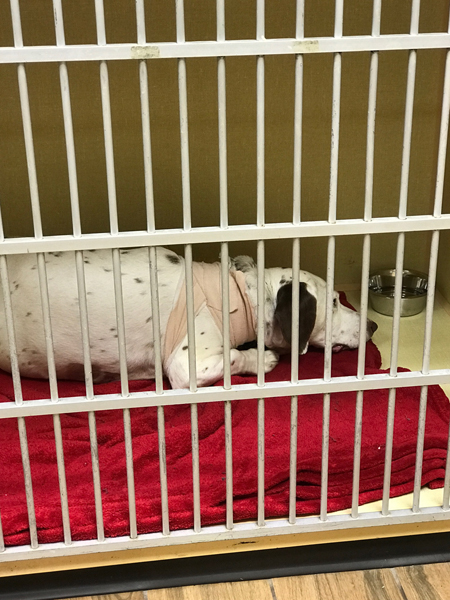Orthopedic Surgeries
A 4 1/2 year-old cat with a humeral fracture. We repaired it using an intramedullary pin and cerclage wire. When the fracture is healed, the IM pin will be pulled, and the cat will be up and running.
This was a fracture of the right tibia. It is another example of an intramedullary pin being placed and closed prior to putting the leg in a splint. Healing went great and the dog was up and four-legged in six weeks.
This young owl had a wing injury and fractured her humerus. We were able to secure the fracture with a surgical stainless steel wire using a cerclage pattern, and she was fully healed in 6 weeks.
This young capuchin monkey had a metabolic bone disease issue. Metabolic bone disease is a concern with an endocrine issue or improper nutrition. It often leads to bone fractures because of the lack of calcium structure, or soft bones that grow improperly. Nutrition is extremely important in these cases.
This is a fracture of the left femur in a Pit Bull mix male dog. This radiograph was taken a little over a year after the surgery. The Intramedullary pin had been removed and the cerclage wire remains with a great healing at the fracture site.
This Pomeranian had a medial luxating patella. An issue where the knee and ligament do not line up straight so the knee cap tends to pop to the inside of the knee and out of the joint. Over time, the patella rubs in and out from the patella groove and that becomes a very shallow cradle. This is the groove that we have gone in and deepened and put back in the chondral bone to help deepen and stabilize the knee joint. You can see the straighter alignment after the surgery was done. Other stabilizers can be used if needed.
Here is a fox terrier who fractured his radius and ulna. An intramedullary pin was drilled into the radius and secured and then the proximal end of the radius was toggled over and secured to the IM pin. The tension of the muscles and support of a splint makes it perfect to heal with no secondary arthritic issues or other frustrations.
This is a humeral fracture from a very young boxer puppy. There was concern of putting an individual or a pin through a growth plate.
Using this technique, it stabilized the humeral fracture without causing a stunted growth of the humeral length or arthritis in the joints. The dog grew up to have a normal healthy life.
This is an 11-year-old German Shepherd with severe issues in his back - degenerative intervertebral disc disease. The inflammation has been going on so long that it is beginning to try to fuse together and stabilize itself. This causes compression and pain of the pinched IV disc pushing up into the spinal canal and pushing on the spinal cord. A lot of sharp pain in the back occurs and numbness in the rear leg area or back half of the dog.
Skyler is a 4 1/2 year-old cat whose left front leg was caught in the fan belt under the hood of a truck. It is common in the spring and winter to get up under the car engine for warmth and these injuries can be devastating. The fracture could have been repaired but there was a total loss of blood supply and nerve innervation.
One week post op up. He is happy and running around as if nothing had happened. Skyler has learned to compensate very well.
This is Falcor. He is a 12-year-old neutered, male basset mix. He had a cervical disc rupture, and this is soon after his surgery. Two examples of cervical disc recovery are included in the videos below.

This next one is a seven year old malamute male that you saw in the second half of the video. He also had a cervical disc rupture. Looking at the x-ray you can see at cervical space 4/5 it has collapsed and calcified.

Here are 4 examples of dogs with Anterior Cruciate Ligament (ACL) injuries. These videos were shot within one to two weeks of post surgical repair.